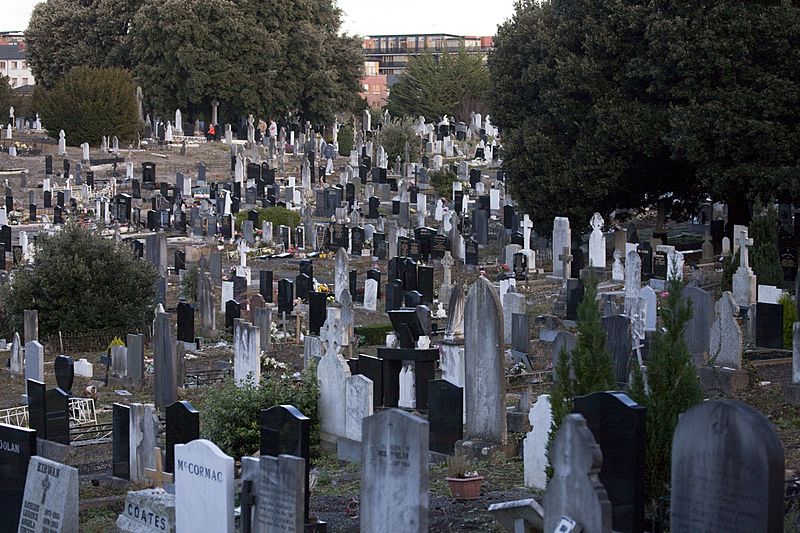Image: Glasnevin Cemetery - More than 1,000,000 Graves (4164589746)

Description: Glasnevin Cemetery, officially known as Prospect Cemetery, is the largest nondenominational cemetery in Ireland. It first opened in 1832 and is located in Glasnevin, Dublin. Prior to the establishment of Glasnevin Cemetery, Irish Catholics had no cemeteries of their own in which to bury their dead and as the repressive Penal Laws of the eighteenth century placed heavy restrictions on the public performance of Catholic services, it had become normal practice for Catholics to conduct a limited version of their own funeral services in Protestant cemeteries. This situation continued until an incident at a funeral held at St. Kevin's Cemetery in 1825 , provoked public outcry when a Protestant sexton reprimanded a Catholic priest for proceeding to perform a limited version of a funeral mass. The outcry prompted Daniel O'Connell, champion of Catholic rights, to launch a campaign and prepare a legal opinion proving that there was actually no law passed forbidding praying for a dead Catholic in a graveyard. O'Connell pushed for the opening of a burial ground in which both Irish Catholics and Protestants could give their dead dignified burial. The cemetery is located in Glasnevin, Dublin, in two parts. The main part, with its trademark high walls and watchtowers, is located on one side of the road from Finglas to the city centre, while the other part, "St. Paul's," is located across the road and beyond a green space, between two railway lines. Glasnevin Cemetery contains many historically interesting monuments as well as the graves of many of Ireland's most prominent national figures — Charles Stewart Parnell and Daniel O'Connell as well as Michael Collins, Éamon de Valera, Arthur Griffith, Maude Gonne, Kevin Barry, Sir Roger Casement, Constance Markiewicz, Brendan Behan, Seán MacBride, Jeremiah O'Donovan Rossa, Christy Brown, Frank Duff, Luke Kelly of the Dubliners. Boyzone singer Stephen Gately was cremated at Glasnevin Crematorium, which is located within the cemetary grounds, on October 17th, 2009. The cemetery also offers a view of the changing style of death monuments in Ireland over the last 200 years: from the austere, simple, high stone erections of the period up until the 1860s, to the elaborate Celtic crosses of the nationalistic revival from the 1860s to 1960s, to the plain Italian marble of the late twentieth century. Glasnevin Cemetery has grown from its original nine to over 120 acres. The high wall with watch-towers surrounding the main part of the cemetery was built to deter bodysnatchers, who were active in Dublin in the 18th and early 19th century. The watchmen also had a pack of blood-hounds who roamed the cemetery at night. Prime Minister, Robert Peel, when questioned in Parliament on the activities of the body-snatchers, admitted that it was, indeed, a "grave matter". Glasnevin is one of the few cemeteries that allowed stillborn babies to be buried in consecrated ground and contains an area called the Angels Plot.
Title: Glasnevin Cemetery - More than 1,000,000 Graves (4164589746)
Credit: Glasnevin Cemetery - More than 1,000,000 Graves Uploaded by AlbertHerring
Author: William Murphy from Dublin, Ireland
Usage Terms: Creative Commons Attribution-Share Alike 2.0
License: CC BY-SA 2.0
License Link: https://creativecommons.org/licenses/by-sa/2.0
Attribution Required?: Yes
Image usage
The following page links to this image:

